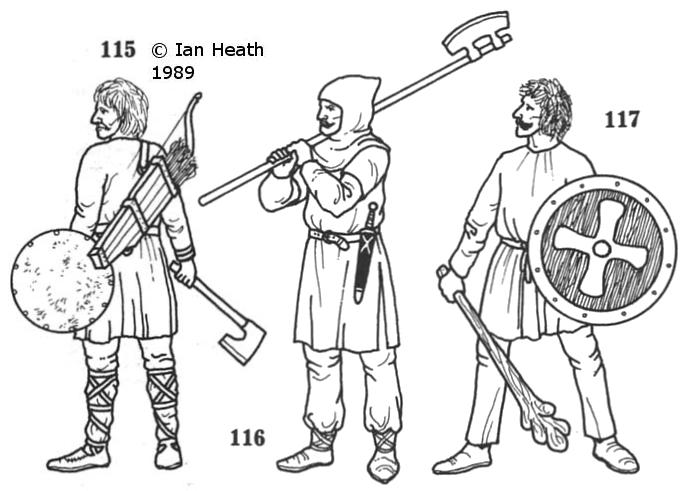
POLISH PEASANT INFANTRYMEN, 11th-13th CENTURIES
An extract from Armies of Feudal Europe 1066-1300by Ian Heath

115, 116 & 117. POLISH PEASANT INFANTRYMEN, 11th-13th CENTURIES
Polish dress remained basically unchanged throughout this era, consisting of an unbleached linen or woollen tunic and trousers, the tunic often having 2 or 3 red bands at cuff and collar, and the trousers being either cross-gartered or gathered at the ankles. A sheepskin jerkin shaped like a poncho, with the fur on the inside, could be worn in winter, while the tunic sleeves were often rolled up in the summer. The elders and upper classes wore longer tunics of strong linen embroidered at collar, cuffs and hem and dyed, predominantly in shades of red, blue and brown, or else left unbleached (grey) like their leggings. By the 13th century lower-class tunics could also be coloured, though mainly only in dull greens and browns. Shoes were usually leather, but the poorest wore bast shoes of birch fibres. Lower-class men equipped like these supplied the bulk of Polish infantry, wearing no metal defensive armour except for the occasional helmet and fighting mainly with polearms, bows and slings. The bow, about 3-4 feet in length, was carried in a combined bowcase/quiver of wood slung either across the back or from the waistbelt.
Principal defensive weapons consisted of an axe, a knife or a crude wooden club, sometimes studded with nails. 116, who dates to the latter part of this period, is armed with a long-handled axe, probably an early version of the famous berdish or berdische, which appeared by the 13th century at the latest. In addition he wears a tunic and hood that are made up of several layers of wool or linen for protection, often quilted like a gambeson. The shield of about 18" diameter carried by 115 is constructed from 2 layers of interwoven osiers covered in leather or sheepskin with the fleece outermost. Though seemingly flimsy the flexibility of this type of shield enabled it to absorb fairly heavy blows without splintering. Alternatively oval, circular or ‘almond’ types might be carried, that of 117 (who dates to the 11th-12th centuries) being reinforced by a cruciform arrangement of iron strengtheners.
The ‘page-boy’ hairstyle of 115 and 117 is typical of the lower classes, noblemen generally having shoulder-length hair. In addition most men wore a moustache (a sign of manhood in Eastern Europe) but only the nobility seem to have generally worn beards. Most Poles had blue or grey eyes and blonde or light brown hair, except for those of Silesia and Little Poland who tended to have dark hair.